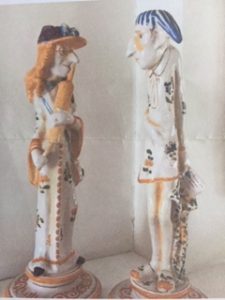 A local doctor, who reads my column, received this humorous pair of candlesticks from a patient almost 40 years ago. This thoughtful patient purchased them in Paris 20 years prior to that. What follows is a tale of a hidden meaning in what appears to be a course joke. That’s what I love about the sneaky, subversive, usually lighthearted, delivered with a wink, French sense of humor. This sense of humor hasn’t changed for hundreds of years, as we see in the decorative arts of the 18th century.
A local doctor, who reads my column, received this humorous pair of candlesticks from a patient almost 40 years ago. This thoughtful patient purchased them in Paris 20 years prior to that. What follows is a tale of a hidden meaning in what appears to be a course joke. That’s what I love about the sneaky, subversive, usually lighthearted, delivered with a wink, French sense of humor. This sense of humor hasn’t changed for hundreds of years, as we see in the decorative arts of the 18th century.
The doctor writes me that he wants to describe the action portrayed. The medic is ready for action implied in the pair. “He holds a giant enema syringe as the patient holds back a gown, open in the back, and carries a chamber pot.” This is a fine pair and a fine subject for a doctor’s study, don’t you think?
These works were produced by a factory in Desvres, a famous location for both tiles and dishware and figures since the 1600’s. This pair dates from the 1930, and stands almost 24 inches tall. The subject of an enema and the doctor is dear to the French heart, and had been reinterpreted in many of the lower-class provincial decorative arts of the 18th century, for a good political reason!
The French entrepreneur, artist, and potter, Joseph Olery Moustiers created both the subject matter and the original edition of the sticks. By the way, in those days when Moustiers lived, the cure for a bellyache was just what is happening in the figural portrayal. In addition, we can find another, more hidden meaning to the subject as well, and we will describe that later as having to do with the French Revolution.
Moustiers himself founded an 18th century factory in the faience capital of the world, Provence. His kiln produced 18th century faience, which is also called tin glazed earthenware, with an iron-white glaze on soft clay, such as terracotta. As we will learn, the factory under Moustiers stopped production in the late 18th century, only to be revitalized in the 20th century. Faience was ‘the people’s ceramic, as opposed to bone china porcelain owned by the upper classes. In the 18th century, porcelain was owned only by the very wealthy.
We see that this pair dates from the second generation of this delicate, distasteful (yet humorous) theme, from the mid-20th century, when so many objects of the 18th century were reproduced. This marks the first wave of French provincial revival furniture and decorative arts, and revival of everything 18th century in the second quarter of the 20th century.
We see the pair is contemporary because of the signature on the base. The initials interlaced are “J.O.,” for the mark of the artist’s two first names, Joseph Olery. This inscription for years was reserved for works that this artist pioneered from the Décor Moustiers Fait Main, even though the artist disappeared in the late 18th century. However, Joseph Olery Moustiers developed this theme, such as it is, and he is thereby ‘honored’ with the application of his signature. This mark was much copied, so fakes abound.
Mousteirs, an intrepid artist, became aware of the Crown’s opinion that Spanish Majolica (the Spanish version of faience) was desirable. Mousteirs traveled to Spain to find the secret of Spanish faience, and returned to France to develop his brand. The popularity of his style undid him in an age of no copyright laws, and he faded from view, but his themes and his kiln remained.
Before you decide the subject pictured on these sticks truly off color, remember the political tone of France in the mid-18th century. Yes, this pair was cast in the 20th century but they’re copies of the artist’s original theme. You will see that the cap worn on the patience is called a Phrygian Cap. In those days under-privileged about to fight for liberty in the French revolution wore that cap. The patient therefore symbolizes the under-classes who blamed the nobility for their ills. Note also that the doctor wears the long hair and the bows of the nobility of the 18th century. So embodied in this course depiction is a political statement easily understood and seen as subversive by people in the 18th centuy. The value of the pair in good condition is $500.